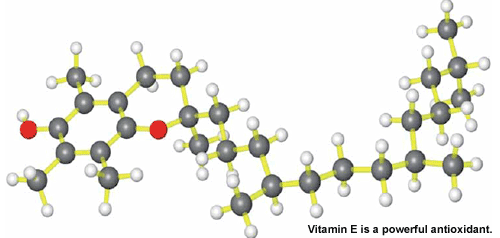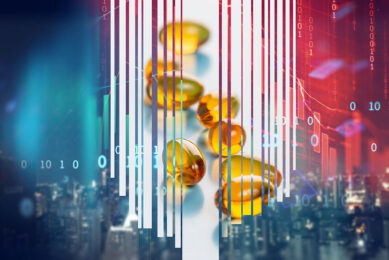Vitamin E with other antioxidants form the wisest combination

Antioxidants are used in feeding stuffs to delay their oxidative spoilage and thus protect oxidation-sensitive lipids and nutrients such as vitamins during the storage of the feeding stuffs. Vitamin E is the most important fat soluble antioxidant and performs best in combination with other antioxidants.
By Dr. Antje Holthausen, Lohmann Animal Health, Cuxhaven, Germany
Fats, oils and feeding stuffs containing fats spoil due to a number of different degradation processes. Fat or lipid oxidation is one of the most important degradation processes, the reaction rate of which is influenced by the impact of oxygen, high temperatures and long storage period in addition to the composition of fatty acids. Feeding with oxidised feeding stuffs not only leads to exposing the animals with a high number of free radicals, thus inducing oxidative stress, it also leads to decreased vitamin E content in the tissue which has a negative impact on animal health and the quality of foods of animal origin.
Vitamin E – the cell-protection vitamin
Vitamin E is for certain the most important fat-soluble antioxidant in the animal organism. This vitamin is of great significance in the organism for the maintenance and stability of cell membranes. It protects the cells against attacks by free radicals and thus prevents stress-related damage to heart and skeletal muscles. High doses of vitamin E are particularly important in high-performance animals to maintain good health and for the quality of the flesh and fatty tissue. The content of vitamin E in the tissue is directly linked to the quality and storage stability of meat. The majority of conventional supplements of vitamin E exceed the physiological requirements of the animals by far.
The recommended supply allows for considerable safety margins as very high supplementation with vitamin E is said to have so-called “add-on effects” such as improved immune competence, improved udder health and better meat quality. Further safety margins are made for feeding long-chain, polyunsaturated fatty acids and also in case of poor fat quality. It is difficult to determine the optimal supply with vitamin E as the individual metabolism and feeding situation of each animal has a strong influence on its requirements of vitamin E. In addition, the tolerance range for vitamin E is very wide, thus meaning that the danger of overdosing is highly unlikely.
Absorption of vitamin E
The absorption of vitamin E takes place together with the absorption of fat in the small intestine. The rate of absorption is equally dependent upon the fat content and fat quality. The uptake of oxidised fatty acids leads to a considerable decrease in the absorption of vitamin E. A variety of factors such as animal species and diet composition further lead to differing quantities of vitamin E being stored in the organism even when supplied the same amount.
Feeding oxidised fats leads to decreased contents of vitamin E in muscle tissue. The lower absorption rate is not the only problem here. The increased formation of free radicals results in a decrease in the endogenous antioxidative potential and further results in the cell structures being destroyed. For this reason oxidative stress is often considered to be the cause of many secondary diseases (sequelae).High contents of vitamin E protect the cell structures. Supplementation with high levels of vitamin E leads indeed to higher contents of vitamin E in the organs, muscle tissue and fatty tissue; however, it cannot prevent the oxidation of the feed. Vitamin E is added to the feed in the form of α-tocopherol-acetate. This only obtains its active antioxidative form after the acetate groups have been hydrolysed in the small intestine. In order to prevent the oxidation of the feed it is thus necessary to add effective antioxidants to the feed which protect the feed during storage and in the intestinal tract. Both synthetic antioxidants and naturally-occurring phenolic compounds, so-called flavonoids, such as Catechins, Quercetins, etc. can effectively prevent and/or delay the oxidation of the feedstuffs which vitamin E cannot do.
Substitute antioxidants
For a while now the use of other antioxidants, such as flavonoid-rich plant extracts, e.g. green tea extract and grape marc, as an alternative to high doses of vitamin E has been a topic for discussion.
With the aid of various in vitro methods it is possible to determine the antioxidative capacity of a plant extract in comparison to Trolox, a derivative of vitamin E. The antioxidative potentials of these plant extracts as determined in in vitro studies are partly used to make a direct comparison with vitamin E. However, a correlation between the potentials determined in vitro and their physiological significance is highly questionable. In vivo trials in rats have shown that flavonoids taken up orally are already conjugated to a great extent in the small intestine and eliminated via the mucous membrane of the small intestine and gall bile. The distribution of the active substance in various tissues was determined during long-term studies with oral application of Quercetin. It became apparent that a notable accumulation could only be determined in those organs which are involved in the metabolism and excretion of the flavonoids. On the other hand the lowest concentrations were detected in the brain and in muscle and fatty tissue. In contrast to this higher supplementation with vitamin E also leads to higher contents of vitamin E in muscle and fatty tissue. These results are a clear indication that the function of vitamin E in intermediate metabolism cannot be taken over by other substances. Vitamin E can thus not be replaced by other antioxidants in respect of its function at cell level.
Influence on meat quality
Similar effects to those achieved with vitamin E supplementation on various parameters surrounding meat quality could be observed in a number of studies on the use of technical antioxidants and plant extracts.
In a study by Surai and Dvorska (2002) on the influence of vitamin E supplementation on vitamin E content and oxidation stability of breast muscle, 40, 100 or 200 mg vitamin E was supplemented per kg basal diet. In addition to the vitamin E content in the breast muscle tissue the malondialdehydes (MDA) as oxidation products were also measured in the muscle tissue. The trials clearly show the influence of the supply of vitamin E on the vitamin E content in the breast muscle and the effects of this on the oxidative stability of breast muscle. The same correlations could also be verified for other productive livestock. In a study on pigs by Ashgar et al. (1991) the vitamin E supply varied between 10 mg/kg in the basal diet and 100 resp. 200 mg/kg in the supplemental diets. This study also showed that the amount of vitamin E stored in both the abdominal fat and the muscle tissue is clearly higher following supplementation of vitamin E in the feed. The content of vitamin E in the meat also correlated here to the oxidative stability of the meat. The use of synthetic and natural antioxidants can have a positive influence on meat quality. In a study by Lopez-Bote (1998) on the influence of rosemary and sage extracts on lipidoxidation in broilers similar effects to those achieved with vitamin E supplementation could be determined.
Either 100 mg vitamin E, rosemary oleoresin or sage oleoresin were added to a control diet containing 10 mg vitamin E per kg. The oxidation products in the breast muscle were determined directly following slaughter and following storage at 4SDgrC after three, six and nine days. While no differences between the treatments were apparent directly after slaughter, the MDA increased considerably in the control groups during the course of storage. The oxidative stability was improved in this trial by both the supplementation of vitamin E as well as rosemary and sage.
Influence of antioxidants on vitamin E transfer
Similar studies with comparable results were also carried out with other plant extracts such as grape marc. The positive effects of antioxidants, however, are obviously not based on the same mode of action as vitamin E. From trials carried out by Bartov (1981) with synthetic antioxidants it is known that the concentrations of vitamin E in the liver, muscle tissue and fatty tissue also increase when the dosage of vitamin E remains the same but synthetic antioxidants are added.
One of the effects which could be observed when using antioxidants is an increase in the transfer rate of vitamin E in the organs, muscle and fatty tissue which in turn has an indirect influence on the parameters surrounding meat quality. Thus the presence of antioxidants belongs to the factors influencing vitamin E transfer. An increase in the concentration of vitamin E in animal products can, therefore, be increased not only by increasing the dosage of vitamin E in the feed.
Vitamin E and antioxidants – a wise combination
Vitamin E plays a major role in the organism of mammals by protecting the membrane structures against destruction by oxidation. It is essential in this function and cannot be replaced by other substances. The use of other antioxidants has further functions which are linked to vitamin E supply. They serve as radical catchers and prevent an extreme influx with harmful hydroperoxides which form during the course of fat oxidation. Furthermore, antioxidants can improve the efficacy of vitamin E supplementation.
An adequate supply with vitamin E and ensuring long-term optimal feed quality by using antioxidants must therefore be considered as the wisest combination.
Join 26,000+ subscribers
Subscribe to our newsletter to stay updated about all the need-to-know content in the feed sector, three times a week. Beheer
Beheer









 WP Admin
WP Admin  Bewerk bericht
Bewerk bericht